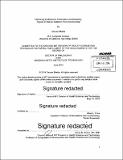Estimating evolutionary parameters and detecting signals of natural selection from genetic data
Author(s)
Bhatia, Gaurav
DownloadFull printable version (5.374Mb)
Other Contributors
Harvard--MIT Program in Health Sciences and Technology.
Advisor
Alkes L. Price.
Terms of use
Metadata
Show full item recordAbstract
Even prior to the elucidation of the structure of DNA, the theoretical foundations of population genetics had been well developed. Advances made by Sewall Wright, John B.S. Haldane, and Ronald A. Fisher form the basis with which we understand the statistical dynamics of evolution and inheritance. Using this foundation, recent advances in DNA profiling technologies have enabled genome-wide analysis of thousands of individuals from a diverse array of human populations. These new analyses can answer fundamental questions about human population differences, natural selection, and admixture. However, with this deluge of newly available data, confusion about statistical methods may lead to misleading conclusions about human population history and natural selection. We view it as imperative to put analyses of population differences on sound statistical footing. In the course of this thesis, we have developed methods and reanalyzed existing results in two related areas: the detection of natural selection and estimation of genetic distance. Throughout our work, we have strived for statistical rigor, attempting to understand variation in previously reported results and provide a resource for other researchers in our field. Where necessary, we have made simplifying assumptions about evolutionary processes but have attempted to state these clearly and validate their reasonableness using simulations. Our efforts have culminated in three projects that will be described in the subsequent chapters: (1) A model based approach to detect natural selection in 3 populations (2) A protocol to generate consistent estimates of FST and, (3) Reanalysis of previously reports of selection in African Americans since the arrival of their ancestors in the Americas. We note that our work is just part of a rich literature on population and evolutionary genetics. We have attempted to cite this literature in detail and have published our own methods to enable others to utilize and improve upon them.
Description
Thesis: Ph. D., Harvard-MIT Program in Health Sciences and Technology, 2014. Cataloged from PDF version of thesis. Includes bibliographical references.
Date issued
2014Department
Harvard University--MIT Division of Health Sciences and TechnologyPublisher
Massachusetts Institute of Technology
Keywords
Harvard--MIT Program in Health Sciences and Technology.